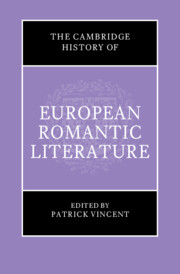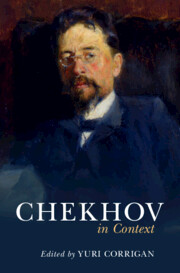85 results
Chapter 9 - Drama
- from Part II - Literature
-
-
- Book:
- Goethe in Context
- Published online:
- 16 May 2024
- Print publication:
- 23 May 2024, pp 86-94
-
- Chapter
- Export citation
11 - Staging Racial Passing
- from Part II - Black Optics
-
-
- Book:
- The Cambridge Companion to the Black Body in American Literature
- Published online:
- 09 May 2024
- Print publication:
- 16 May 2024, pp 159-175
-
- Chapter
- Export citation
Chapter 9 - Melville
- from Part III - Some Literary Models
-
-
- Book:
- Robert Lowell In Context
- Published online:
- 28 March 2024
- Print publication:
- 04 April 2024, pp 98-107
-
- Chapter
- Export citation
Chapter 17 - World-Drama: Wagner’s Hegelian Heritage
- from III - Politics, Ideas, and Bodies
-
-
- Book:
- Wagner in Context
- Published online:
- 14 March 2024
- Print publication:
- 14 March 2024, pp 168-177
-
- Chapter
- Export citation
Chapter 9 - Franz Liszt
- from II - People
-
-
- Book:
- Wagner in Context
- Published online:
- 14 March 2024
- Print publication:
- 14 March 2024, pp 95-103
-
- Chapter
- Export citation
6 - Loathsome Sympathy
-
-
- Book:
- Percy Shelley for Our Times
- Published online:
- 07 March 2024
- Print publication:
- 14 March 2024, pp 133-155
-
- Chapter
- Export citation

The Cambridge History of European Romantic Literature
-
- Published online:
- 10 January 2024
- Print publication:
- 09 November 2023
Chapter 30 - Puccini’s Legacy, Influence, and Meaning
- from Part VIII - Legacy
-
-
- Book:
- Puccini in Context
- Published online:
- 31 August 2023
- Print publication:
- 14 September 2023, pp 247-255
-
- Chapter
- Export citation
Chapter 11 - Drama and Acting in Puccini’s Italy
- from Part III - Influences and Interests
-
-
- Book:
- Puccini in Context
- Published online:
- 31 August 2023
- Print publication:
- 14 September 2023, pp 89-96
-
- Chapter
- Export citation
1 - Demons and Deliverance: Discourses on Pentecostal Power
-
- Book:
- Performing Power in Nigeria
- Published online:
- 24 August 2023
- Print publication:
- 07 September 2023, pp 29-65
-
- Chapter
-
- You have access
- Open access
- HTML
- Export citation
Chapter 3 - Commensality and Theatricality at the Dinner Party
-
- Book:
- Edible Arrangements
- Published online:
- 26 September 2023
- Print publication:
- 31 August 2023, pp 100-138
-
- Chapter
- Export citation
From ritual to performance: Ta'zieh in Iran today
-
- Journal:
- Iranian Studies / Volume 56 / Issue 4 / October 2023
- Published online by Cambridge University Press:
- 24 August 2023, pp. 671-684
- Print publication:
- October 2023
-
- Article
- Export citation
Chapter 14 - Convent and City
- from IV - Genre and Gender
-
-
- Book:
- Women and Medieval Literary Culture
- Published online:
- 28 July 2023
- Print publication:
- 17 August 2023, pp 285-298
-
- Chapter
- Export citation
Preface
-
- Book:
- Wilkie Collins in Context
- Published online:
- 27 July 2023
- Print publication:
- 10 August 2023, pp xvii-xxi
-
- Chapter
- Export citation
Chapter 17 - The Embodied Feminist Futures of Diaspora
- from Part III - Readings in Genre, Gender, and Genealogies
-
-
- Book:
- Diaspora and Literary Studies
- Published online:
- 20 July 2023
- Print publication:
- 10 August 2023, pp 300-313
-
- Chapter
- Export citation
8 - The Arts of Culture
-
- Book:
- Middle Imperial China, 900–1350
- Published online:
- 20 July 2023
- Print publication:
- 03 August 2023, pp 191-216
-
- Chapter
- Export citation
18 - Fragile Realism
- from Part II - Forms, Genre, and Media
-
-
- Book:
- The Cambridge History of American Modernism
- Published online:
- 13 July 2023
- Print publication:
- 20 July 2023, pp 318-333
-
- Chapter
- Export citation
Chapter 6 - Dramatic Methods of Teaching
- from Part III - Theatre, Education, and Worker Wellbeing
-
- Book:
- Theatre in the Chocolate Factory
- Published online:
- 23 June 2023
- Print publication:
- 13 July 2023, pp 200-230
-
- Chapter
- Export citation
Chapter 4 - ‘O, what a sympathy of woe is this’
-
- Book:
- Sympathy in Early Modern Literature and Culture
- Published online:
- 27 April 2023
- Print publication:
- 13 April 2023, pp 139-175
-
- Chapter
- Export citation

Chekhov in Context
-
- Published online:
- 16 February 2023
- Print publication:
- 23 February 2023



